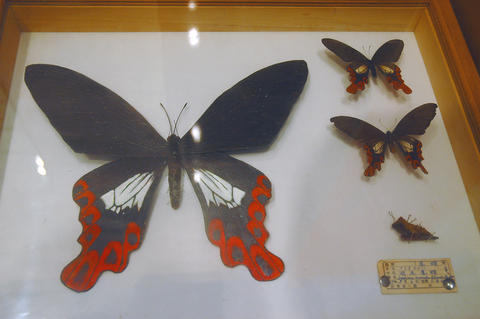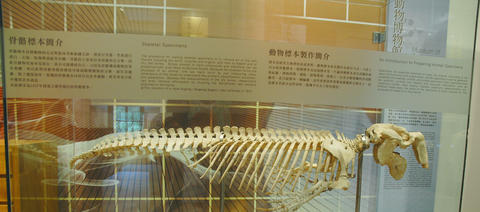National Taiwan University (臺灣大學, NTU) recently commemorated its 80th anniversary by opening six of its 12 academic museums to the public and plans to open another three next year.
"The collections in each museum were originally for research purposes," said Tsai Chiung-min (蔡烔民), a researcher at NTU's Center of Digital Archives. "For this reason, we didn't make them accessible to the public."
If public museums use their collections to attract visitors who are after general knowledge, research museums serve the opposite function by keeping specimens or artifacts for the exclusive use of experts.

PHOTO: NOAH BUCHAN, TAIPEI TIMES
To make the museums visitor friendly, Tsai said, the university renovated and expanded existing facilities - mostly dusty basements and messy storerooms.
"In the past," he said, "we feared that people would say, 'Why is it not clean enough? Why is it not like a regular museum?'"
Historical significance

A first stop on any visit should be the Gallery of NTU's History (校史館) because it includes a brief introduction to each museum. Located a few minutes' walk from NTU's main gate at the Gongguan MRT station, the Gallery is housed on the second floor of a Japanese-era colonial building.
The exhibition displays books, pictures and files documenting some of Taiwan's most momentous events including the White Terror era, the 1970s Student Protest Movement, Taiwan's withdrawal from the UN and NTU's direct elections for student representatives, to name a few.
One section, Services to Society, showcases research at the university that has provided practical benefits to humankind. The Pursuit of Excellence section highlights public figures.
The Gallery's Chuan Lyu Exhibition Hall (川流廳) houses the Window to University Museums section, where artifacts, pictures and specimens are used to give a brief introduction to each museum. The hall also features interactive displays and video presentations.
Around campus
The department of anthropology has two museums, one in the Exhibition Hall of Archaeology and one in the Exhibition Hall of Ethnology. The first collection consists of Aboriginal artifacts collected between the 1920s and 1960s and focuses on the burial customs and tombs of prehistoric Taiwan.
The collections in the Exhibition Hall of Ethnology date from 1895 and were moved to NTU when it opened in 1928. To promote ethnological research, two Japanese anthropologists systematically collected specimens including clothing, woodcarving, ceramics, daily utensils and ceremonial objects of Taiwan's Aboriginal tribes, which are on display.
On the first floor of the Life Science Building, the Museum of Zoology contains more than 100 mounted specimens and skeletons of birds, mammals, reptiles and fish. The museum currently features a special exhibit, A New Experience of Life Science, and displays toothed whales, baleen whales and Asian elephants - all accompanied by the sounds made by these giants.
A bronze statue of a farmer points the way to the Agricultural Exhibition Hall. Opened in 1964, the hall is as much a tribute to Taiwan's agricultural progress as it is a museum. It is also a worthy stop for plant lovers as it shows in detail the diversity of plants and trees found on NTU's sprawling campus.
The Exhibition Hall of Geological Collections houses a rich collection of the island's fossils, minerals and rock samples as well as specimens collected and purchased from other countries. The museum features a special exhibit about hokutolite, the only mineral in the world named after a place in Taiwan (it is the Japanese pronunciation of Beitou).
The mineral was assumed to have radioactive properties - Nobel laureate and former Academia Sinica president Lee Yuan-tseh (李遠哲) wrote his master's thesis on the topic - and was used as part of linear accelerator experiments in the department of physics. Highlights of the research and Taiwan's first accelerator can be found at the Heritage Hall of Physics.
Though the Insect Museum and Herbarium of National Taiwan University will not open to the public until next year, enthusiasts can still get an idea of what to expect from the displays at the Chuan Lyu Hall.
The prehistoric artifacts, minerals, fossils, specimens of plants, animals and insects, combined with the variety of laboratory instruments and equipment will interest a wide variety of scholars and laypeople. Taken together, they provide an in-depth look at the development of NTU's sciences and humanities over the past century.

On April 26, The Lancet published a letter from two doctors at Taichung-based China Medical University Hospital (CMUH) warning that “Taiwan’s Health Care System is on the Brink of Collapse.” The authors said that “Years of policy inaction and mismanagement of resources have led to the National Health Insurance system operating under unsustainable conditions.” The pushback was immediate. Errors in the paper were quickly identified and publicized, to discredit the authors (the hospital apologized). CNA reported that CMUH said the letter described Taiwan in 2021 as having 62 nurses per 10,000 people, when the correct number was 78 nurses per 10,000

As we live longer, our risk of cognitive impairment is increasing. How can we delay the onset of symptoms? Do we have to give up every indulgence or can small changes make a difference? We asked neurologists for tips on how to keep our brains healthy for life. TAKE CARE OF YOUR HEALTH “All of the sensible things that apply to bodily health apply to brain health,” says Suzanne O’Sullivan, a consultant in neurology at the National Hospital for Neurology and Neurosurgery in London, and the author of The Age of Diagnosis. “When you’re 20, you can get away with absolute

May 5 to May 11 What started out as friction between Taiwanese students at Taichung First High School and a Japanese head cook escalated dramatically over the first two weeks of May 1927. It began on April 30 when the cook’s wife knew that lotus starch used in that night’s dinner had rat feces in it, but failed to inform staff until the meal was already prepared. The students believed that her silence was intentional, and filed a complaint. The school’s Japanese administrators sided with the cook’s family, dismissing the students as troublemakers and clamping down on their freedoms — with

As Donald Trump’s executive order in March led to the shuttering of Voice of America (VOA) — the global broadcaster whose roots date back to the fight against Nazi propaganda — he quickly attracted support from figures not used to aligning themselves with any US administration. Trump had ordered the US Agency for Global Media, the federal agency that funds VOA and other groups promoting independent journalism overseas, to be “eliminated to the maximum extent consistent with applicable law.” The decision suddenly halted programming in 49 languages to more than 425 million people. In Moscow, Margarita Simonyan, the hardline editor-in-chief of the